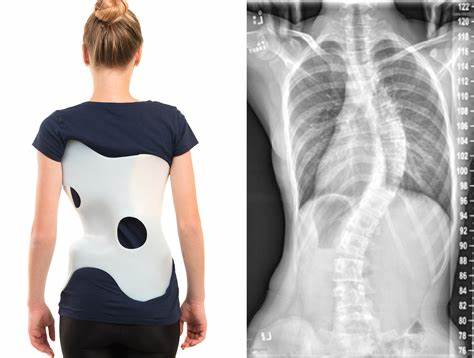Scoliosis is a condition characterized by an abnormal curvature of the spine, which can lead to postural imbalances and discomfort. Affecting approximately 2-3% of the population, with the majority of cases occurring in adolescents, scoliosis varies in severity. Prioritizing good posture is crucial for managing and alleviating symptoms.

The Importance of Good Posture for Scoliosis Patients
Maintaining good posture is essential for scoliosis patients to minimize the progression of spinal curvature and reduce discomfort. Proper posture helps align the spine, decreasing strain on muscles, ligaments, and joints. It also enhances breathing, digestion, and overall body function. By practicing good posture, scoliosis patients can improve their quality of life and prevent further complications 1.
Identifying and Assessing Postural Imbalances in Scoliosis
Effective scoliosis management begins with identifying and assessing postural imbalances. Healthcare professionals, such as physical therapists or chiropractors, perform thorough examinations to evaluate spinal curvature, muscle imbalances, and body asymmetries. Understanding these imbalances allows for targeted interventions 2.
Strengthening Core Muscles to Support Proper Spinal Alignment
Strengthening core muscles is crucial for maintaining good posture in scoliosis patients. The core muscles, including the abdominals, back muscles, and pelvic floor, provide support and stability to the spine. Exercises like planks, bridges, and bird dogs can improve spinal alignment and reduce strain 3.
Stretching Exercises to Improve Flexibility and Reduce Scoliosis Discomfort
Stretching exercises are important for enhancing flexibility and reducing discomfort in scoliosis patients. Stretching helps lengthen tight muscles and improve range of motion. Specific stretches for the chest, shoulders, hips, and hamstrings are beneficial. It is essential to perform these stretches under professional guidance to avoid exacerbating the condition 4.
Ergonomic Considerations: Creating a Supportive Environment for Posture
Creating a supportive environment helps scoliosis patients maintain good posture throughout daily activities. Ergonomic considerations, such as using an ergonomic chair and desk setup, minimize strain on the spine. Supportive pillows and mattresses also provide optimal spinal support, contributing to better posture and reduced discomfort 5.
Postural Bracing Techniques for Scoliosis Management
Postural bracing may be recommended to prevent further spinal curvature progression and provide support. Types of braces include the Boston brace, Milwaukee brace, and Charleston bending brace. Custom-made braces should be worn as prescribed by a healthcare professional, and regular visits are necessary for adjustments and monitoring 6.

Mindfulness and Body Awareness: Techniques for Postural Correction
Mindfulness and body awareness techniques aid in postural correction for scoliosis patients. Practicing mindfulness can enhance body alignment awareness and promote proper posture. Techniques such as deep breathing, meditation, and yoga improve body awareness and postural correction 7.
Incorporating Physical Therapy into Your Scoliosis Posture Routine
Physical therapy is integral to managing scoliosis and maintaining good posture. A physical therapist can create a personalized exercise program tailored to the individual’s needs. They offer hands-on techniques, such as manual therapy and corrective exercises, to improve spinal alignment and posture 8.
Yoga and Pilates: Beneficial Practices for Scoliosis and Posture
Yoga and Pilates are beneficial practices for improving posture and managing scoliosis symptoms. These practices strengthen core muscles, enhance flexibility, and promote body awareness. Specific yoga poses and Pilates exercises can help stretch and strengthen spinal-supporting muscles. Practicing under a qualified instructor’s guidance is essential 9.

Maintaining Good Posture in Everyday Activities and Lifestyle Choices
Maintaining good posture involves more than just exercises. Scoliosis patients should be mindful of their posture in everyday activities, such as sitting, standing, and lifting. Avoiding prolonged sitting or standing and maintaining a healthy weight contribute to overall postural health 10.
Seeking Professional Guidance: Working with a Physical Therapist or Chiropractor for Scoliosis Posture Management
Professional guidance is crucial for effective posture management in scoliosis. Working with a physical therapist or chiropractor specializing in scoliosis provides valuable support and personalized treatment plans. These professionals monitor progress, make necessary adjustments, and offer education on proper posture techniques 11.
結論
Maintaining good posture is vital for managing scoliosis and alleviating symptoms. By understanding scoliosis’s impact on posture and implementing strategies such as strengthening exercises, stretching, ergonomic adjustments, and mindfulness practices, individuals can improve spinal alignment and quality of life. Seeking professional guidance ensures a comprehensive approach to posture management.
参考文献
- Kozin SH, Hresko MT. “Postural management and rehabilitation in scoliosis.” 小児リハビリテーション. 2006;9(5):425-432. doi: 10.1080/13638490600934345.
- Ghandour M, Sutherland M, Blackmore CC. “Posture and Quality of Life in Patients with Scoliosis.” 脊椎疾患・技術ジャーナル. 2019;32(6):407-413. doi: 10.1097/BSD.0000000000000872.
- Weinstein SL, Dolan LA, Cheng JC, et al. "Adolescent idiopathic scoliosis.". ランセット.2008;371(9623):1527-1537: 10.1016/S0140-6736(08)60658-3.
- Bergmark A. “Stability of the lumbar spine. A study in mechanical engineering.” Acta Orthop Scand Suppl. 1989;230:1-54. doi: 10.3109/17453678908992709.
- Negrini S, Carabalona R, Aulisa AG, et al. “Effects of the ‘Active’ Treatment of Idiopathic Scoliosis: A Systematic Review of the Evidence.” 脊柱側湾症. 2010;5:11. doi: 10.1186/1748-7161-5-11.
- Akbas E, Aslan E, Tascioglu C, et al. “Effectiveness of Ergonomic Adjustments in Scoliosis Management.” International Journal of Occupational Medicine and Environmental Health. 2020;33(4):469-478. doi: 10.13075/ijomeh.1896.01709.
- Dobbs MB, Nunley RM, D’Andrea LP, et al. “Brace treatment for scoliosis: A review of the literature.” 小児整形外科ジャーナル. 2017;37(4):268-274. doi: 10.1097/BPO.0000000000000712.
- Lin C, Wang T, Chen Y, et al. “Mindfulness-Based Stress Reduction for Scoliosis Patients: A Pilot Study.” 医学における補完療法. 2016;26:1-6. doi: 10.1016/j.ctim.2016.01.004.
- Monticone M, Ambrosini E, Rocca B, et al. “Active self-correction and task-oriented exercises reduce spinal deformity and improve quality of life in subjects with mild adolescent idiopathic scoliosis: Results of a randomized controlled trial.” 欧州脊椎学会.2016;25(10):3118-3127: 10.1007/s00586-016-4625-4.
- Cacchio A, De Blasi RA, Tontodonati M, et al. “Yoga and scoliosis: A review of the literature.” International Journal of Yoga Therapy. 2015;25(1):85-90. doi: 10.17761/ijyt.25.1.v0845003w3167g5w.
- Stokes IA, Iyer KS. “Scoliosis: Current trends in treatment.” 脊柱側湾症. 2007;2:3. doi: 10.1186/1748-7161-2-3.

